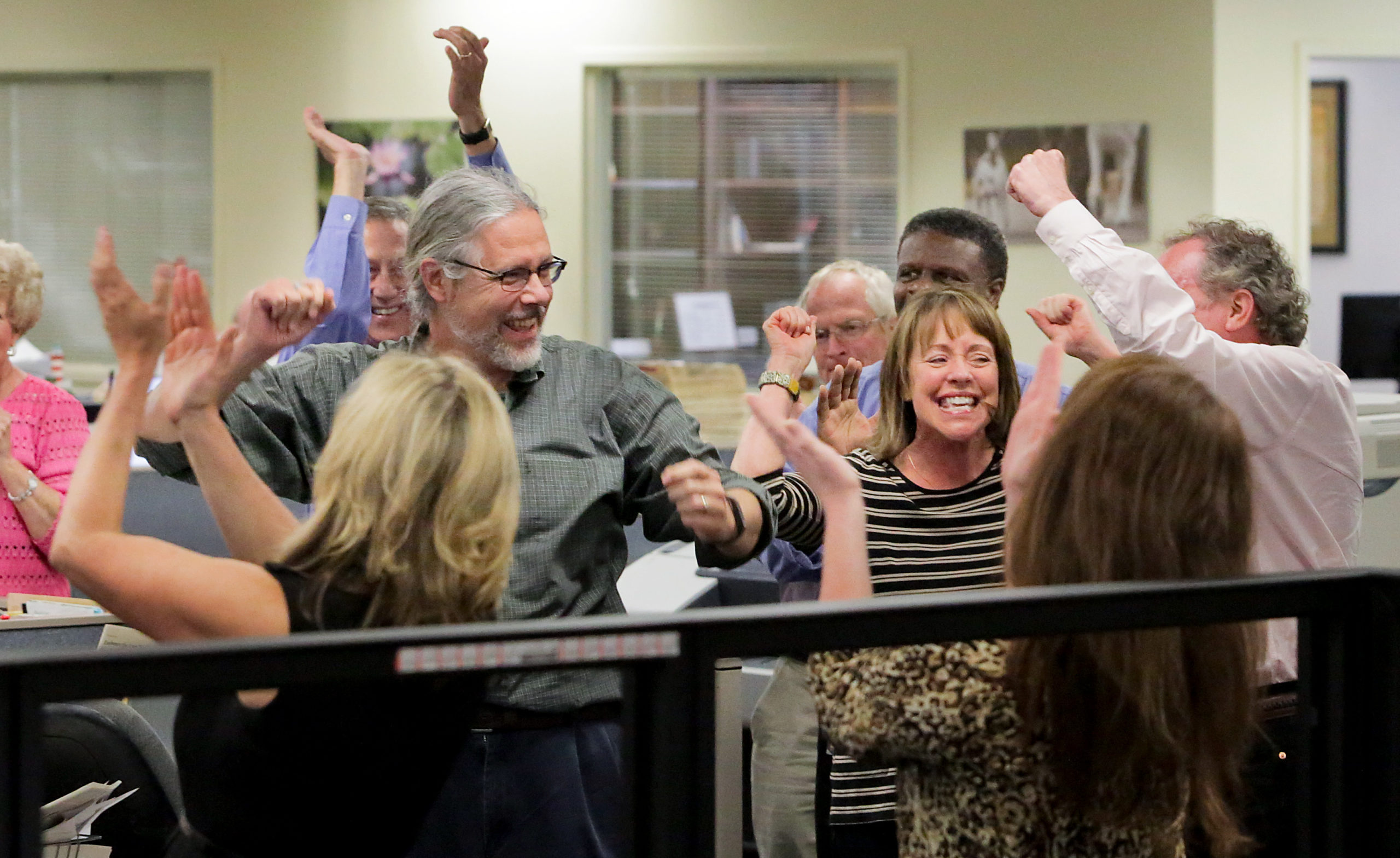Beware of road metaphors.
In the twisty-turny devolution of the local press since The Great Recession, we’ve been driven down pathways, ramps, routes, shortcuts, and, unfortunately, many dead-ends.
Which brings us to the metaphor of the moment: The Roadmap for Local News.
The newest would-be mapping of “what’s wrong with local news” was presented to leaders of major foundation funders, including MacArthur, Ford, Knight, Emerson Collective, and Democracy Fund and then published last month. The group met outside Palm Springs in Rancho Mirage, at the old Annenberg Estate, Sunnylands, the last weekend in January. Jim Friedlich, chief executive officer of The Lenfest Institute for Journalism, recently offered a great summary of it here.
Related Posts
Dear Sunnylands, Make More Room for BIPOC, LGBTQ, and Rural Media Leaders at the Table
Legacy Media Needs to Be Transformed, Not Discarded
Meet The States Using Public Funding to Support Local Journalism
Report from Sunnylands: Revitalizing Local News with New Capital, Creativity, and Collective Action
Sunnylands must have been a great oxymoronically named placed to address the ever-dimming issue that has consumed more than a decade: the widening erosion of local news that has presented as a tableau of news deserts and ghost newspapers, their mastheads still intact, but filled with non-local content. It is wonderful to see serious funders acknowledge this “local news emergency,” though we must ask whether there should be a statute of limitations on that phrase given it’s lasted so long — the last newspaper reports on year-over-year growth go back to 2008.
Call it what we will, alarm is warranted. Finding directions on the landscape that exists today is a top priority for the many discussions unfurling in the months ahead.
That’s why we need to assess this particular roadmap.
Overall, it’s well-intentioned with lots of fine sights along the way, callouts to numerous innovators, and some good ideas for much-needed new development.
Rationalization of tech stacks? Check.
Better networking of mission-driven regional news sites? Check.
Building diversity and real inclusivity into the very fabric of local news, in content and in staffing? Check.
Shared services that work? Check.
Really engage with all our populations? Check.
Unfortunately, though, the manifesto misses the mark in two essential functions of any journalistic cartography. First, it omits so many places on the map of local news, places that may be inconvenient reminders that the world — today’s or the world as we would like to envision it — is quite diverse and nuanced. Secondly, it fails to offer what any roadmap requires: a destination that is real, achievable, and satisfying.
Most strikingly to many who have read it, the report seems to strain for detours around two words that should drive this discussion — local news. And it elevates the term “civic information,” a new world populated by “practitioners, stabilizers, champions, networks and communities of practice,” over the words journalism and journalists
We can all agree that civic information is good, and community betterment, words the roadmap doesn’t include, would be even better. We can all agree that digital media uniquely can drive far better actionable localized civic information than was ever before possible, but that leads us to a first equation:
Civic information ≠ local news
Local news, created, vetted, and presented smartly by skilled editors, reporters, and the product people now so essential to our models, leads the way. It creates large, caring audiences — who can then benefit from civic information as never before.
In the authors’ distaste for the financially driven owners who are sucking the last dollars out of what they believe to be a dying trade, they paint a world of old and new, with the new in infant form and the old to be discarded as quickly as possible.
One problem here:
Print local news ≠ hedge-fund-gutted dailies
For more than a decade, I’ve covered, analyzed, and decried the destruction that financially driven companies like Alden and Gannett have done. At the same time, though, I’ve recognized that such financially driven companies make up about half of dailies in the country. Independent, civic-driven dailies, such as the Minneapolis Star-Tribune, The Seattle Times, The Philadelphia Inquirer, and The Charleston (SC) Post and Courier, show the life — and potential digital transformation — of many remaining formerly “print” operations. They are joined by literally hundreds of medium and small dailies, and, let no one forget, substantial weeklies, across the country serving millions of local citizens. A good number of these companies still bear their families’ names, and they speak to the pride of decades of perseverance.
Yet they are unmapped here.
The roadmap makes them — and their place on the real map of the 2020s — invisible. Not to include them means throwing out the still-striving babies with the distasteful bathwater of the financially driven chains.
Then there are the larger start-up, digital-only operations that, too, got left off the roadmap.
LION Publishers and the Institute for Nonprofit News count hundreds of members, most of them striving to create new local news organizations. They are a diverse lot, but too few of them got marked on the roadmap, and some of them have demonstrated the potential to play bigger roles in their communities’ futures.
Then thereare the mission-driven organizations that are already replacing flagging dailies in their communities. They include a half-dozen aggressive, growing startups that are well on the way to doing that, including The Baltimore Banner, Block Club Chicago, The Colorado Sun, the Daily Memphian, the Long Beach Post, and my own Lookout Local/Lookout Santa Cruz. I’ve written about these peer companies, as we’ve met and shared best practices, and you will soon hear more about our collective plans.
What distinguishes these six — and there are more out there across the country — is their intent to replace the dailies that are failing their communities. That means both taking in sufficient investment to fund newsrooms of sufficient scale — enough skilled, diverse journalists who can create, day after day, go-to products that build sizable and engaged audiences. It also means running these community-centric operations as majority earned-revenue businesses — offering a high enough level of product and service to win membership/subscription, advertising, events, and other income.
“Are we there yet?” we may hear from the backseat.
No, but less than five years old and building through Covid-19 times, all are on track to earn a majority of their revenue from readers and advertisers.
All are mission-driven. Some are 501(c)3s. Others are for-profit public benefit corporations. And that’s another key equation here:
Digital news start-ups ≠ nonprofits, only
In the orthodoxy of some who believe they are leading the nonprofit news revival movement, that above equation is infuriating and thus apparently leads to incomplete mapmaking.
Why? There’s a certain comfort with the seeming purity of the term nonprofit — which is understandable, but simplistic — and a major discomfort with business-building and entrepreneurial zeal that experience has shown is vital to forging new sustainable news operations.
Instead, it suggests a curious group of new world builders: “We recommend that a coalition of media practitioners, pro-democracy advocates, funders, and government leaders join forces to ensure that civic information rapidly becomes a ubiquitous asset in every community in the United States.” Many of us want to keep government leaders at arms’ length from local journalism, and for good reason — we cover those sources of power and hold them accountable. Here, too, the role of publishers, editors, and reporters (or are those the discarded terms for “media practitioners”?) vanishes from the roadmap.
Further, the document is blind to the great journalism long and currently created by for-profit companies. The roadmap’s great embrace of the alternative-to-news term of “civic information” has also come under recent scrutiny as some of the roadmap presenters have launched the “Civic News Company” just days after the Sunnylands conference closed.
This roadmap’s orthodoxy maps an inexplicable religiosity of faith over fact and offers a “news must be free” mantra. That disastrous chant should be (thank you, New York Times) an artifact of 1998, when Silicon Valley tech deked news companies with that creed.
Limiting access by paywall? That’s verboten here. In fact, in 2023, intelligent paywalls are beginning to allow us to get membership/subscription money from those who can and will pay — and increasingly serve those who can’t, or won’t, in other ways.
Orthodoxy should be so contrarian to journalists, who, after all, are taught to question everything. In fact, the very name of this mapping, The Roadmap to Local News, speaks to the problem. There is no single roadmap. You may have a roadmap — or a new product/business model — but it is just one roadmap or model, not the true path claim that journalists, by nature, can quickly pick apart.
Which leads to another equation:
Successful, mission-driven news organizations ≠ mandated, free-for-all, no access restrictions operations
The report misrepresents a fundamental reason that print newspapers served much — but not all — of the country so well for so long. It sums up the current downward spiral of many of the dailies over-simplistically: “The public goods being produced by the newspaper business model — civic information that benefited even those who didn’t pay for it like coverage of local government, courts, and schools — were being subsidized by consumer and advertiser demand for coverage of sports and entertainment and utilities.”
Subsidy is a popular word thrown about in explanation and is, in part, true. What it fails to acknowledge is this huge point: Tens of millions of Americans actually paid for something they prized — local news.
Further, the explanation misunderstands advertiser demand then and now. Advertisers wanted news section placement, with relatively significantly less demand for sports or entertainment coverage. Most importantly, today, advertising — anathema to too many in the news start-up trade — is in demand by locally owned small businesses aiming to reach local audiences. Such advertising not only offers an important revenue stream — but is community affirming.
In advocating for paywall-free sites, the roadmap seemed to target itself at philanthropy, and that, in and of itself, seems misguided. Why? Dollars and sense: There isn’t enough willing and able philanthropy to fund all the needed thousands of local news outfits in the United States. (A big point, too, on which I will only spend a sentence here: The local news collapse is seen across all democracies, and most of them do not have the philanthropic tradition or framework we do, necessitating greater-than-philanthropy solutions.)
An important equation:
Digital news start-ups ≠ philanthropically dependent organizations
Philanthropy here should be a great partner — and has already been, in fits and starts. What’s needed is the new alignment of philanthropy with sensible, market-driven business building.
Philanthropy can be fundamental to success — but as early, substantial, game-changing, scale-building investment, and likely as a good supplement over time.
In the end, in the speculative business of new mapmaking, words matter. Ecosystem, a word much prized in this roadmap, is a great goal. It would be wonderful to have such “an interconnected system” that works well for our local democracies. But we don’t. It’s broken, disconnected. Creating a new one won’t be done on paper, or at conferences, but community by community by those investing in and invested in the long-standing bedrock values of local journalism.
Most emphatically, as we face faster-declining local news and the still-rising forces of modern know-nothingism, this is not a time for orthodoxy. It’s a time for an inclusive road-mapping that drives our communities forward.
Ken Doctor currently serves as a national business of news analyst and CEO/founder of Lookout Local/Lookout Santa Cruz. His 48-year-career in journalism encompasses alternative weeklies, monthly magazines, newsroom and newspaper management and digital innovation, including 21 years with Knight Ridder Newspapers in both digital and print executive capacities.




